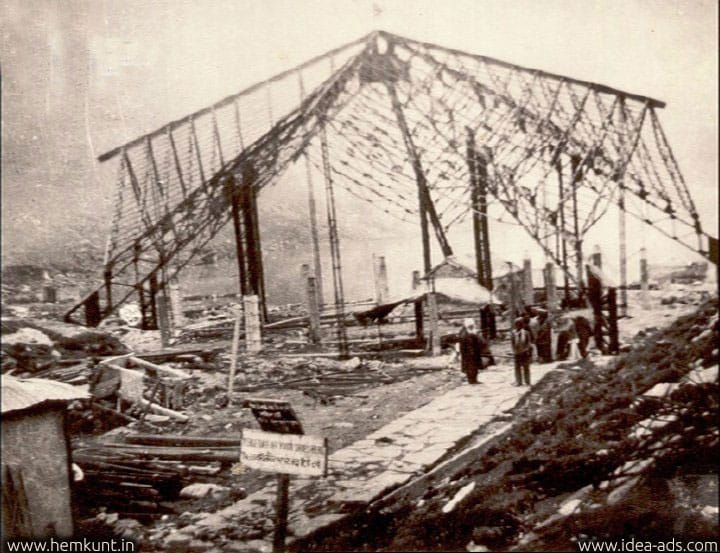Discover the captivating story of Hemkund Sahib, a revered Sikh pilgrimage site nestled amidst the towering peaks of the Himalayas. From its humble origins as a secluded mountain lake to its transformation into a beacon of faith, Hemkund Sahib holds profound significance for the Sikh community. As we trace its historical journey, we’ll uncover the spiritual essence that draws devotees from around the world, exploring its cultural impact and the enduring legacy it holds for the Sikh diaspora.
History of Hemkund Sahib
High in the breathtaking Himalayas lies Hemkund Sahib, a place revered by Sikhs as a sacred pilgrimage destination for centuries. The very air at Hemkund Sahib seems to vibrate with history and spiritual energy.
The Name “Hemkund”
The name “Hemkund” itself provides a clue to the site’s nature. “Hem” translates to “snow,” and “Kund” means “bowl,” a fitting description for the glacial lake nestled among the towering, snow-capped peaks.
Guru Gobind Singh’s Connection
Hemkund Sahib is profoundly connected to Guru Gobind Singh, the tenth Sikh Guru. The Dasam Granth, a sacred Sikh text, suggests that Guru Gobind Singh meditated at this very spot in a previous lifetime, experiencing the same breathtaking views and powerful atmosphere.
Building a Gurudwara at 15,000 Feet
In the mid-1960s, the present gurudwara (temple) at Hemkund Sahib was constructed, a remarkable feat considering its location atop a mountain. Architect Manmohan Singh Siali and contractor Gursikh Sahib Singh masterminded the intricate design and overcame daunting logistical challenges posed by the altitude and terrain. Their achievement stands as a testament to their skill and unwavering dedication.
The Pilgrimage: A Journey of Body and Soul
Sikhs undertake the journey to Hemkund Sahib as a pilgrimage, a challenging endeavor involving steep climbs and demanding trails. However, the pilgrimage represents more than just reaching the destination; it’s about the transformative journey itself. Pilgrims often engage in “kar seva” – selfless service – along the way, contributing to the path’s maintenance and supporting fellow travelers. This spirit of service is integral to Sikh belief, emphasizing that true spiritual growth involves physical and selfless action.
Construction Challenges: A Symphony of Faith and Engineering
Building the Hemkund Sahib gurudwara was a dance with nature, as the extreme altitude and rugged terrain presented constant challenges to the construction team. Every stage, from transporting materials to laying foundations, demanded meticulous planning and innovative solutions. Yet, driven by their faith and the ambition to create an enduring tribute to their Guru, they persevered.
Health Considerations: Altitude and Awareness
Visiting Hemkund Sahib requires careful consideration due to its high altitude of 15,000 feet. Altitude sickness is a real concern, and the strenuous trekking and limited water availability emphasize the need for preparation. Proper acclimatization is crucial, and consulting a doctor about potential risks and precautions is essential for anyone planning a trip.
Hemkund Sahib’s Significance to Sikhs
Hemkund Sahib stands as a sacred space for Sikhs, a place where they feel a profound connection to Guru Gobind Singh and his teachings. The site, nestled high in the mountains, embodies the Guru’s spiritual journey, a journey that continues to inspire Sikhs today. Visiting Hemkund Sahib is about honoring that legacy and reaffirming their commitment to the values the Guru embodied.
A Legacy Etched in Stone and Spirit
Hemkund Sahib’s story continues to unfold. Each year, more pilgrims embark on the journey, drawn by its history, spirituality, and awe-inspiring beauty. It is a place where faith and nature intertwine, where whispers of the past echo through the mountain winds, and where the human spirit is tested and ultimately uplifted.
Who Found Hemkund Sahib?
The discovery of Hemkund Sahib, this serene Sikh pilgrimage site nestled high in the Himalayas, was not the act of a single individual but a relay of remarkable individuals, each playing a pivotal role.
- Pandit Tara Singh Narotam (1884): This Nirmala scholar meticulously studied Sikh scriptures and, like a detective deciphering ancient clues, identified the probable location of Hemkund Sahib. His research provided the roadmap for others to follow.
- Sant Sohan Singh (1934): Inspired by Pandit Narotam’s work, this dedicated seeker ventured into the Himalayas, guided by local tales and descriptions from Guru Gobind Singh’s own words. His efforts culminated in the rediscovery of Hemkund Sahib, proving its existence beyond legends.
- Bhai Vir Singh: This respected Sikh historian meticulously verified Sant Sohan Singh’s findings, confirming their authenticity. He then became a powerful advocate for Hemkund Sahib, raising awareness and rallying support for its development into the pilgrimage site it is today.
- Havaldar Modan Singh: This devoted Sikh dedicated his life to Hemkund Sahib. He oversaw the construction of a larger gurdwara, ensuring accessibility for a greater number of pilgrims. Furthermore, he established a trust to guarantee the pilgrimage’s smooth operation and long-term sustainability.
The combined efforts of these individuals, each contributing their unique skills and unwavering dedication across time, illuminate the power of curiosity, perseverance, and a shared reverence for a sacred place.
Which is Higher, Kedarnath or Hemkund Sahib?
Both Kedarnath and Hemkund Sahib, nestled high in the Himalayas, are revered pilgrimage sites, but they differ in altitude and accessibility.
Kedarnath:
- Elevation: 11,755 feet
- Significance: A holy site in Hinduism, dedicated to Lord Shiva.
- Accessibility: Open to pilgrims year-round.
Hemkund Sahib:
- Elevation: 15,000 feet
- Significance: Sacred to Sikhs, believed to be where Guru Gobind Singh meditated in a past life.
- Accessibility: Accessible only during summer months due to heavy snowfall.
Hemkund Sahib stands taller than Kedarnath, reaching an elevation of 15,000 feet compared to Kedarnath’s already impressive 11,755 feet. While determining exact heights in mountainous areas can be complex, it’s clear that Hemkund Sahib claims the higher ground.
How Many Nishan Sahibs are in Hemkund Sahib?
Hemkund Sahib, the sacred Sikh pilgrimage site high in the Himalayas, is characterized by seven vibrant Nishan Sahibs, the iconic Sikh flags, fluttering atop the surrounding summits. These flags, a powerful symbol of faith, contribute to the unique spiritual atmosphere of Hemkund Sahib.
The significance of the number seven is a subject of debate among scholars. Some connect it to ancient numerology and its importance across cultures, while others suggest it might symbolize the seven chakras, the energy centers in the human body. Regardless of the interpretation, the seven Nishan Sahibs at Hemkund Sahib represent a powerful visual expression of faith.
What is the Rooftop of Guru Hemkund Sahib Like?
The rooftop of the Guru Hemkund Sahib is uniquely designed in the shape of an inverted lotus flower, a symbol laden with meaning in Sikhism.
The lotus often represents purity, resilience, and spiritual growth. Its inverted position on the rooftop is open to interpretation. It could symbolize a reminder to remain grounded in humility even while striving for enlightenment. Alternatively, it might represent detachment from worldly desires, emphasizing a focus on spiritual pursuits over material possessions.
As with many religious symbols, the inverted lotus on the rooftop of Guru Hemkund Sahib invites contemplation and personal interpretation.
What is the Story Behind Hemkund Sahib?
Hemkund Sahib, a breathtakingly beautiful place in the Himalayas, has a story deeply intertwined with faith and rediscovery. Its connection to Guru Gobind Singh, the tenth Sikh Guru, makes it a place of profound significance.
A Lost Sanctuary
For centuries, the exact location of this sacred space remained shrouded in mystery. Then, in the 19th century, Pandit Tara Singh Narotam, a dedicated Nirmala scholar, immersed himself in ancient texts, believing they held the key to finding Hemkund Sahib. His research led him to pinpoint the probable location of this lost sanctuary.
Rediscovery and Devotion
Inspired by Pandit Narotam’s work, Sant Sohan Singh embarked on a mission in 1934 to physically locate Hemkund Sahib, guided by clues and a deep sense of purpose. His success in finding the site marked a pivotal moment.
From Rediscovery to Pilgrimage
The magnificent Gurudwara that graces Hemkund Sahib today, completed in the 1960s, stands as a testament to the devotion and tireless efforts of the Sikh community. Building at such a high altitude, battling harsh weather and unforgiving terrain, was a monumental undertaking. The successful completion of the Gurudwara reflects their unwavering faith.
The Pilgrimage: A Journey of Faith and Selflessness
Hemkund Sahib draws thousands of Sikh pilgrims each year, and the journey itself is a pilgrimage. The trek is demanding and pushes individuals to their limits, but it’s also seen as a deeply spiritual experience. Along the route, pilgrims engage in ‘kar seva’—selfless service—maintaining the path and supporting their fellow travelers. It embodies the spirit of community, reflecting the Sikh emphasis on selfless action as a path to spiritual growth.
Hemkund Sahib’s story is still being written with each passing year, as more people make the journey to experience its history, spirituality, and breathtaking beauty. It’s a testament to the enduring power of faith and the human spirit.
How Old is Hemkund Sahib?
Determining the exact age of Hemkund Sahib is a journey through time and faith, with clues scattered throughout history.
Ancient Mentions and Modern Construction
The Dasam Granth, a sacred book for Sikhs, alludes to a location that bears a striking resemblance to Hemkund Sahib, suggesting its existence potentially predates the structures visible today.
In the 19th century, Pandit Tara Singh Narotam’s meticulous research, using historical maps and textual analysis, provided the first concrete identification of Hemkund Sahib’s location. Sant Sohan Singh’s physical rediscovery of the site in 1934 further confirmed its existence and fueled efforts for its development.
Bhai Vir Singh, a respected historian, validated Sant Sohan Singh’s findings and recognized the historical and spiritual significance of Hemkund Sahib. His efforts were instrumental in garnering support for its development.
A Testament to Faith and Perseverance
The construction of the gurudwara at Hemkund Sahib, perched at a daunting 15,000 feet, was a feat of engineering and unwavering faith. The architects and builders overcame immense logistical challenges to create a structure that has withstood the test of time and harsh Himalayan weather.
While the precise date of Hemkund Sahib’s establishment remains shrouded in the mists of time, its narrative is one of rediscovery, faith, and human perseverance. It serves as a potent symbol of how a place can embody both ancient significance and modern rejuvenation, a testament to the enduring power of belief.
Who Found the Gurudwara?
The question of who “found” a Gurudwara, specifically Hemkund Sahib, is complex, as it’s more about rediscovering and highlighting a site embedded within Sikh tradition.
Rediscovering a Sacred Site
Imagine a story passed down through generations, where the exact location mentioned becomes blurred over time. People know of its existence but are unsure of its precise whereabouts. This is similar to what happened with Hemkund Sahib.
In the late 19th century, Pandit Tara Singh Narotam, a scholar well-versed in Sikh history and scriptures, dedicated himself to pinpointing the location of Hemkund, a place described in Sikh texts. His research led him to the Himalayas, where he identified the likely location of this forgotten sanctuary.
Confirmation and Advocacy
In 1934, inspired by Pandit Narotam’s work, Sant Sohan Singh embarked on a determined expedition to locate Hemkund Sahib. Using the clues meticulously gathered by Pandit Narotam, he successfully rediscovered the site. Bhai Vir Singh, a prominent Sikh scholar, corroborated Sant Sohan Singh’s discovery, further solidifying the site’s significance within Sikh tradition.
Developing and Maintaining Hemkund Sahib
Upon confirmation, the focus shifted to making Hemkund Sahib accessible to pilgrims. Sant Sohan Singh entrusted this monumental task to Havaldar Modan Singh, who dedicated his life to the site’s development. He oversaw the construction of a larger Gurudwara, making it a suitable place of worship, and established a trust to ensure the smooth administration of the pilgrimage.
The Challenging Pilgrimage
Reaching Hemkund Sahib is a pilgrimage that demands physical and mental fortitude. The trek through the Himalayas is arduous, with steep climbs, unpredictable weather, and the ever-present risk of altitude sickness. Yet, Sikhs undertake this journey driven by faith and a yearning for spiritual growth.
The journey itself is seen as an act of devotion. Pilgrims practice “kar seva” (selfless service), supporting each other and contributing to the path’s upkeep. It’s a testament to the belief that the journey to Hemkund Sahib is as important as the destination itself, pushing individuals to test their limits, connect with their faith, and experience the transformative power within.
The story of Hemkund Sahib highlights the collaborative efforts and unwavering dedication involved in rediscovering and developing this sacred site. It emphasizes that it was not the achievement of a single person but a collective endeavor fueled by shared faith and a deep reverence for their heritage.
Who Found Amritsar?
Amritsar, the spiritual center for Sikhs worldwide, owes its origins to Guru Ram Das, the fourth Sikh guru. In 1577, he chose the site and envisioned it as a holy city, naming it Amritsar, meaning “pool of nectar,” after the sacred pool he created, the Amrita Saras.
A Legacy of Visionaries
Guru Arjan Dev, the fifth Sikh guru, further enriched Amritsar’s spiritual significance by conceiving the Golden Temple in 1588. This iconic structure, also known as Harmandir Sahib, rises from the heart of the Amrita Saras, accessed by a shimmering marble causeway. It symbolizes peace and spiritual connection.
Maharaja Ranjit Singh, a towering figure in Sikh history, amplified the Golden Temple’s grandeur. In the early 19th century, he commissioned the embellishment of the temple’s upper floors with gold foil, cementing its popular name as the “Golden Temple.”
Amritsar’s Turbulent Past
Despite its spiritual aura, Amritsar’s history bears witness to tragedy. The Jallianwala Bagh Massacre of 1919, where British troops opened fire on unarmed civilians, remains a dark stain. In 1984, the Indian army’s assault on the Golden Temple, in response to militant activity, inflicted further pain and continues to evoke sorrow.
Amritsar Today
Amritsar stands as a potent symbol of faith, resilience, and the enduring spirit of the Sikh people. It continues to draw pilgrims and visitors from all corners of the globe, who come to pay homage, seek solace, and immerse themselves in the city’s vibrant culture and history. The echoes of its past serve as a reminder of the importance of peace, understanding, and the preservation of sacred spaces.
What is the History of Hazur Sahib?
Hazur Sahib, a Gurdwara of profound significance, rests on the land where Guru Gobind Singh, the tenth Sikh Guru, breathed his last in 1708. Situated in Nanded, India, it’s a place where history and spirituality converge.
A Gurdwara Rises from Reverence
Between 1832 and 1837, Maharaja Ranjit Singh, a powerful Sikh ruler, commissioned the construction of Hazur Sahib to commemorate Guru Gobind Singh’s legacy. This magnificent gurdwara, known as Takht Sachkhand Sri Hazur Abchalnagar Sahib, stands as a testament to the Guru’s impact.
Guru Gobind Singh’s Enduring Legacy
Guru Gobind Singh’s presence resonates deeply within Hazur Sahib. He spent his final years in Nanded, leaving an indelible mark on the city and the Sikh faith. This is where he bestowed the Guruship upon the Guru Granth Sahib, the sacred Sikh scripture, declaring it the eternal guide for the Sikh community.
Architectural Grandeur and Spiritual Hub
Hazur Sahib’s architecture reflects a blend of Mughal and Sikh influences, a testament to the region’s rich cultural tapestry. The Sachkhand, the central structure, houses the Guru Granth Sahib, emanating an aura of profound reverence.
A Beacon of Faith for Millions
For Sikhs globally, Hazur Sahib represents a beacon of faith, drawing pilgrims seeking solace, enlightenment, and a connection to their spiritual roots. The gurdwara pulses with activity, hosting annual celebrations like Hola Mohalla, a vibrant three-day festival filled with color, martial displays, and religious fervor.
The story of Hazur Sahib is deeply woven into the fabric of Nanded. Guru Gobind Singh’s presence fostered an unbreakable bond between the Sikh community and the people of Nanded, where a thriving Sikh population exists to this day.
What is the Height of Hemkund Sahib from Earth?
Hemkund Sahib, perched high in the Himalayas, stands at an elevation of 4,572 meters (15,000 feet) above sea level. This altitude, placing it among the clouds, contributes to its otherworldly atmosphere and the sense of spiritual significance it evokes.
A Challenging Ascent
Reaching this sacred site involves a physically demanding trek that starts from Govindghat, leading to Ghangaria after a 9-kilometer journey. From Ghangaria, pilgrims ascend another 1,100 meters on a paved path to reach the revered shrine.
A Test of Faith and Endurance
Every year, approximately 150,000 pilgrims undertake this challenging journey, demonstrating unwavering faith and resilience. They brave steep inclines, unpredictable weather conditions, and the risk of altitude sickness to reach Hemkund Sahib, seeking spiritual solace and a connection with their faith.
Reaching for the Divine
Hemkund Sahib’s breathtaking beauty, with its serene glacial lake reflecting the towering, snow-capped peaks, offers a profound sense of peace and awe. It’s a reminder of the power of faith to inspire individuals to push their limits, overcome obstacles, and seek a deeper connection with the divine.
















